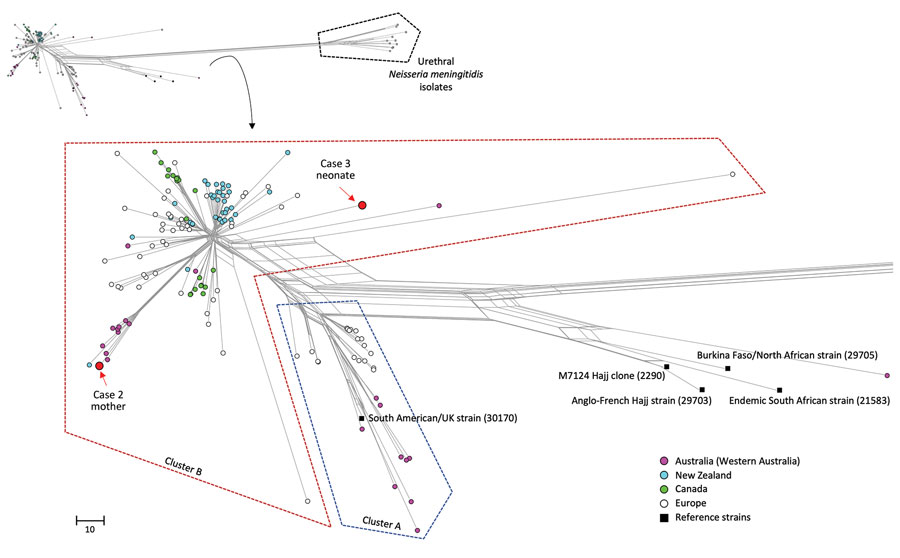Volume 30, Number 2—February 2024
Dispatch
Obstetric and Neonatal Invasive Meningococcal Disease Caused by Neisseria meningitidis Serogroup W, Western Australia, Australia
Figure 1

Figure 1. Phylogenetic relationship of 2 invasive Neisseria meningitidis serogroup W (MenW:cc11) strains from 3 mother-baby pairs with invasive meningococcal disease in Western Australia, Australia, compared with other local and international isolates. The neighbor-net phylogenetic network was constructed based on 1,605 core genome loci using the Genome Comparator tool available on the PubMLST Neisseria website (https://pubmlst.org/organisms/neisseria-spp). Red indicates the 2 isolates reported in this study ; pink circles indicate isolates from Western Australia reported by Mowlaboccus et al. (1); blue, green, and white circles indicate isolates from the Australian Penicillin Resistance–Associated Lineage reported by Willerton et al. (3) from New Zealand, Canada, and Europe, respectively; black squares indicate reference invasive MenW/cc11 strains characterized by Lucidarme et al. (4). Identification numbers in parentheses indicate PubMLST identification numbers of reference isolates. Inset at top shows full phylogenetic trees; callout at left shows urethral N. meningitidis strains strains from Tzeng et al. (2) and Ma et al. (5), which were isolated from urethral swabs in the United States (NM1, NM2), the United Kingdom (M11_240294, M11_241043, M13_240559), Italy (PE5, PE6, PE7), and France (LNP26948, LNP27256). Scale bar indicates number of different loci among the 1,605 compared.
References
- Mowlaboccus S, Jolley KA, Bray JE, Pang S, Lee YT, Bew JD, et al. Clonal expansion of new penicillin-resistant clade of Neisseria meningitidis serogroup W clonal complex 11, Australia. Emerg Infect Dis. 2017;23:1364–7. DOIPubMedGoogle Scholar
- Tzeng YL, Bazan JA, Turner AN, Wang X, Retchless AC, Read TD, et al. Emergence of a new Neisseria meningitidis clonal complex 11 lineage 11.2 clade as an effective urogenital pathogen. Proc Natl Acad Sci U S A. 2017;114:4237–42. DOIPubMedGoogle Scholar
- Willerton L, Lucidarme J, Walker A, Lekshmi A, Clark SA, Gray SJ, et al. Increase in penicillin-resistant invasive meningococcal serogroup W ST-11 complex isolates in England. Vaccine. 2021;39:2719–29. DOIPubMedGoogle Scholar
- Lucidarme J, Hill DM, Bratcher HB, Gray SJ, du Plessis M, Tsang RS, et al. Genomic resolution of an aggressive, widespread, diverse and expanding meningococcal serogroup B, C and W lineage. J Infect. 2015;71:544–52. DOIPubMedGoogle Scholar
- Ma KC, Unemo M, Jeverica S, Kirkcaldy RD, Takahashi H, Ohnishi M, et al. Genomic characterization of urethritis-associated Neisseria meningitidis shows that a wide range of N. meningitidis strains can cause urethritis. J Clin Microbiol. 2017;55:3374–83. DOIPubMedGoogle Scholar
- van Gils EJ, van Woensel JB, van der Ende A, Kuijpers TW. Increased attack rate of meningococcal disease in children with a pregnant mother. Pediatrics. 2005;115:e590–3. DOIPubMedGoogle Scholar
- Parikh SR, Borrow R, Ramsay ME, Ladhani SN. Lower risk of invasive meningococcal disease during pregnancy: national prospective surveillance in England, 2011-2014. BJOG. 2019;126:1052–7. DOIPubMedGoogle Scholar
- Polayes SH, Ohlbaum C, Winston HB. Meningococcus meningitis with massive hemorrhage of the adrenals’ (Waterhouse-Friderichsen syndrome) complicating pregnancy with pre-eclamptic toxemia. Am J Obstet Gynecol. 1953;65:192–6. DOIPubMedGoogle Scholar
- Persa OD, Jazmati N, Robinson N, Wolke M, Kremer K, Schweer K, et al. A pregnant woman with chronic meningococcaemia from Neisseria meningitidis with lpxL1-mutations. Lancet. 2014;384:1900. DOIPubMedGoogle Scholar
- Finan MA, Smith SG, Sinnott JT, O’Brien W, Ibach M, Morales R. An interesting case presentation: peripartum meningococcal meningitis. J Perinatol. 1992;12:78–80.PubMedGoogle Scholar
- Neubert AG, Schwartz PA. Neisseria meningitidis sepsis as a complication of labor. A case report. J Reprod Med. 1994;39:749–51.PubMedGoogle Scholar
- Brandeberry KR, Vergon JM. Meningococcic meningitis in term pregnancy. Am J Obstet Gynecol. 1951;61:699–700. DOIPubMedGoogle Scholar
- Filippakis D, Gkentzi D, Dimitriou G, Karatza A. Neonatal meningococcal disease: an update. J Matern Fetal Neonatal Med. 2022;35:4190–5. DOIPubMedGoogle Scholar
- Basani L, Aepala R. Neisseria meningitidis causing multiple cerebral abscesses in early neonatal period: case report and review of literature. J Clin Diagn Res. 2017;11:SD01–03. DOIPubMedGoogle Scholar
- Achten NB, Been JV, Schoenmakers S, Vermont CL, Verdijk RM, Reiss IKM, et al. Fatal early-onset sepsis caused by intrauterine transmission of serogroup Y meningococcus. Pediatr Infect Dis J. 2022;41:e517–9. DOIPubMedGoogle Scholar